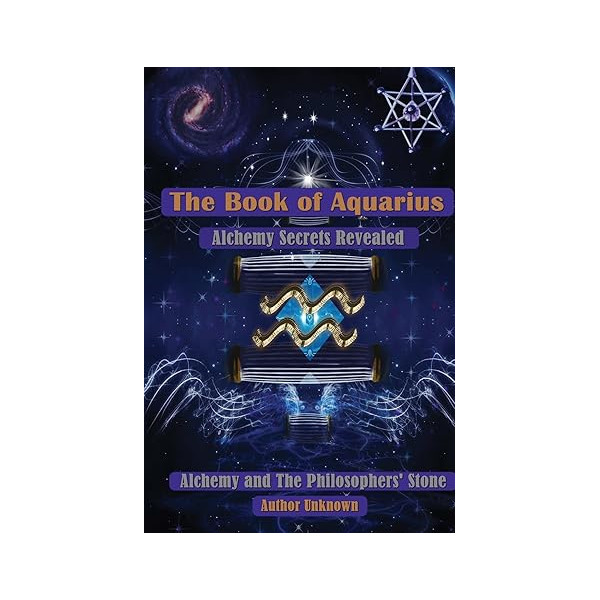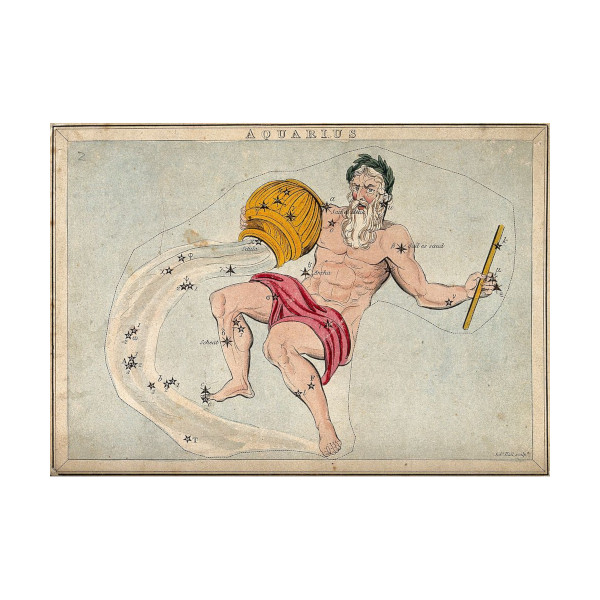
Book Review: The Book of Aquarius (2011)
Introduction
The Book of Aquarius is a remarkable and enigmatic text, written anonymously and first published in 2011. Its central claim is one that has captivated humanity for centuries: that the Philosopher’s Stone, an alchemical substance said to grant immortality and the ability to transmute base metals into gold, is real and can be created using a straightforward process. What sets The Book of Aquarius apart from other alchemical writings is its insistence that the creation of the Philosopher’s Stone is not a metaphorical or spiritual allegory but a literal, physical process that anyone can undertake.
Available for free online, this book has attracted significant attention and controversy, largely due to its detailed step-by-step guide on how to create the Philosopher’s Stone using simple materials. The anonymous author’s approach strips away much of the cryptic and symbolic language that traditionally surrounds alchemical texts, offering instead a method that relies on common substances and accessible techniques. Central to this process is the repeated distillation of human urine, the calcination of solid residues, and the gradual manipulation of heat to foster the transformation of the raw materials into the fabled Stone.
In this review, we will explore the contents of The Book of Aquarius, provide a clear description of the alchemical process outlined within it, and critically evaluate the book’s place within the broader tradition of alchemical literature.
Overview of Contents
The Book of Aquarius is structured as a guidebook, offering both practical and philosophical insights. The author’s goal is to clarify the ancient teachings of alchemy and present them in a form that is accessible to modern readers. The book is broken into various chapters, with the main focus on the practical steps necessary to create the Philosopher’s Stone. Along the way, the author touches on historical alchemical texts and offers their interpretation of the symbols and metaphors that have traditionally been used to obscure alchemical knowledge.
Unlike many other alchemical writings, The Book of Aquarius dismisses much of the mysticism and metaphor often associated with the Philosopher’s Stone. The author asserts that the alchemical process described is not symbolic but literal and physical, with the potential to create a material substance with extraordinary powers. The book seeks to demystify the work of past alchemists, claiming that their writings, while often obscure, describe a real process that can be replicated today.
The Alchemical Process in The Book of Aquarius
The process for creating the Philosopher’s Stone, as described in The Book of Aquarius, is both lengthy and detailed, requiring patience and precision. The key steps of the process include distillation, calcination, putrefaction, and the gradual heating of the materials in a specific vessel. Below is a more accurate and detailed breakdown of the process, reflecting the corrected details you mentioned:
- The First Matter: Urine
The starting material for the alchemical process is human urine, which the author describes as containing the “Prima Materia” or “First Matter.” This may seem surprising or unusual, but it aligns with ancient alchemical traditions that often made use of everyday bodily substances as sources of raw material for transformation. The author instructs the reader to collect a sufficient amount of urine over time, as it will serve as the fundamental ingredient throughout the process. - Distillation of the Essence
The urine is repeatedly distilled to separate the volatile components from the solid residue, which is often referred to as the “feces.” The volatile part, a clear essence, is considered the purified “spirit” or essential component of the First Matter. This distillation process is crucial because it isolates the most important elements from the urine, which will later be recombined with the calcined residue. The collection of this essence is done carefully, and distillation is repeated multiple times to ensure that the spirit is as pure as possible. - Calcination of the Feces
After distillation, the solid material left behind, called the “feces” or “earth,” is subjected to calcination. Calcination involves heating the material to a high temperature until it is reduced to a fine white ash. This ash represents the purified body or “salt” of the material. In The Book of Aquarius, calcination is described as a key step in which the impure, gross matter is broken down, leaving behind only the essential and purified part of the material. The heat used in calcination is much higher than in the later stages of the process and must be sufficient to completely break down the solid residue into ash. - Imbibing and Recombination
Once calcination is complete, the purified spirit or essence that was distilled earlier is gradually reintroduced or “imbibed” into the calcined ash. This recombination of the spirit (the volatile component) with the purified body (the calcined earth) is an important alchemical concept, symbolizing the union of spirit and body. The resulting mixture is then ready for the next stage of the process, where it will undergo transformation. - The Vessel and Luting
The combined material is sealed inside a spherical borosilicate glass vial. Borosilicate glass is chosen because it can withstand the prolonged heat exposure required for the later stages of the process. The spherical shape of the vessel is also significant, as it allows for even heat distribution during the next phases. Once sealed, the vessel is “luted”—a term used in alchemy to describe the process of securing the seal with a heat-resistant material to prevent any air or impurities from entering or escaping during the heating process. This sealing is critical, as the material must undergo transformation in a completely closed environment, isolated from outside contamination. - Putrefaction
After the material has been sealed in the vessel, the next stage is putrefaction, or what alchemists often refer to as the “blackening” (nigredo). During this stage, the material is exposed to gentle, consistent heat over a long period. The author of The Book of Aquarius instructs that the heat applied should be roughly equivalent to the temperature used to hatch chicken eggs, approximately 37–39°C (98–102°F). This heat causes the material to undergo a process of decomposition and fermentation, symbolizing death and the breaking down of the old form so that something new can emerge. The substance turns black, indicating the completion of the nigredo stage. - Albedo: The Whitening
Following the putrefaction phase, the material begins to undergo further transformation. The black substance gradually turns white, marking the beginning of the alchemical phase known as albedo (whitening). This stage symbolizes purification and rebirth, as the material is transformed into a more refined state. During this phase, the temperature must be kept constant and low, ensuring that the transformation occurs slowly and methodically. - Rubedo: The Reddening
Once albedo is achieved, the heat is gradually increased. This slow and controlled increase in temperature facilitates the final transformation of the material, a process known as rubedo (reddening). In alchemical symbolism, rubedo represents the completion of the Great Work—the creation of the Philosopher’s Stone. As the material turns red, it signifies that it has reached its ultimate state of perfection. The Philosopher’s Stone, in its final form, is described as a red powder or stone, possessing the power to transmute base metals into gold and to grant immortality or health to those who use it.
The Vessel and Heat Control
The careful control of heat is one of the most crucial aspects of the entire process. Throughout much of the process, from putrefaction to rubedo, the temperature must be maintained at a level similar to that required for hatching eggs, around 37°C to 39°C (98–102°F). This ensures a slow and steady transformation of the material without burning or damaging it. However, during the calcination stage, the temperature must be significantly higher to reduce the solid feces into ash.
Once putrefaction is complete and the material reaches the albedo stage, the heat is gradually increased, slowly raising the temperature over time. The final stage of rubedo requires a higher temperature to fully bring forth the Stone’s transformative properties, and this is done with great care to avoid overheating or disrupting the material.
This precise control of heat mirrors the alchemical adage “Solve et Coagula”—dissolve and coagulate—a theme that runs throughout the text, symbolizing the breaking down and reformation of matter. The balance between decomposition (putrefaction) and recombination (imbibing and calcination) is central to the creation of the Philosopher’s Stone, and the author stresses that careful attention to these stages is essential for success.
The Philosopher’s Stone: What It Can Do
Once the Philosopher’s Stone is complete, the book claims it can be used for a number of remarkable feats. These include the transmutation of base metals, such as lead, into gold, as well as the healing of diseases and the granting of immortality. The author also emphasizes that the Stone is not merely a material object but is connected to the spiritual transformation of the alchemist who creates it. The process of creating the Stone is as much about inner purification and enlightenment as it is about the physical creation of the substance itself.
The Philosopher’s Stone, according to the book, can be used in two main forms: either as a red powder (used for metal transmutation) or ingested in smaller quantities to heal and extend life. These claims, while consistent with historical alchemical lore, remain unverified in the modern scientific community, and their appeal rests largely on the mythic and esoteric nature of the Stone.
Philosophical Reflections
Although the primary focus of The Book of Aquarius is the practical process for creating the Philosopher’s Stone, the author also delves into some of the deeper philosophical implications of alchemy. The work suggests that the transformation of materials reflects the spiritual journey of the alchemist, and that achieving the Stone represents not only mastery over the material world but also over one’s own soul. This aligns with traditional alchemical thought, which often presents the Great Work (the creation of the Stone) as both a physical and spiritual endeavor.
Interestingly, The Book of Aquarius rejects much of the mystical and symbolic language that pervades traditional alchemical texts, favoring a more straightforward, materialist explanation for the process. However, it retains the core belief that the alchemist’s inner state and moral purity are linked to the success of the alchemical work.
Conclusion
The Book of Aquarius stands as a unique text in the modern study of alchemy. By offering a clear, practical guide to the creation of the Philosopher’s Stone and rejecting the cryptic symbolism of traditional alchemical works, the anonymous author has produced a work that is both accessible and controversial. Whether one believes in the literal claims made by the book or views it as a fascinating exploration of ancient wisdom, there is no denying the allure of the Philosopher’s Stone and the enduring power of alchemy to inspire the imagination.
For those with an interest in alchemy, historical esoterica, or spiritual transformation, The Book of Aquarius provides a compelling read. Whether it succeeds in delivering the Philosopher’s Stone is a question each reader must answer for themselves.
You can download the free pdf

